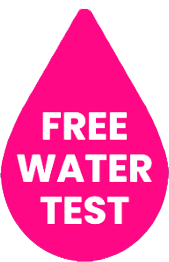If you’ve ever wondered whether you can install a reverse osmosis water filter for the whole house, you’re not alone. It’s a question we get often and it makes sense. Homeowners want the cleanest, purest water possible flowing from every tap, not just the kitchen sink.
The short answer is yes: it is possible to install a whole-house reverse osmosis (RO) system. But the long answer? It’s not always the most practical, cost-effective, or necessary solution for most homes. Whole-house RO systems are complex, expensive, and often require significant maintenance, making them more suitable for specialized situations.
At AAA Water Systems, we typically recommend a more balanced and efficient approach: pairing a whole-house water softener with a reverse osmosis system at the kitchen tap. This combination provides cleaner, healthier water for every use, while giving you high-purity water where you need it most – for drinking, cooking, and food prep.
In this post, we’ll break down how whole-house reverse osmosis systems work, the challenges they come with, and why a blended solution might be the better option for your home.
What Is Reverse Osmosis and How Does It Work?
Reverse osmosis (RO) is a water filtration process designed to remove a wide range of impurities from water using a semi-permeable membrane. When water passes through this membrane under pressure, it filters out contaminants such as chlorine, lead, arsenic, fluoride, nitrates, and even some bacteria and viruses. What’s left is cleaner, better-tasting water with fewer dissolved solids and unwanted chemicals.
RO systems typically involve multiple stages of filtration, starting with sediment and carbon filters to remove larger particles and chlorine, followed by the RO membrane for fine purification. Some systems also include a post-filter or remineralization stage to improve taste and balance.
Because of their high effectiveness, reverse osmosis systems are commonly installed under the kitchen sink or on the counter to supply purified water for drinking, cooking, and beverages. They’re known for being compact, low-maintenance, and one of the most efficient options to deliver high-quality water where it matters most.
While the idea of applying a reverse osmosis water filter for the whole house might sound appealing, it’s important to understand what’s involved in scaling up an RO system to whole-home use. Let’s explore that next…
Can You Get a Reverse Osmosis Water Filter for the Whole House?
Yes, technically you can install a reverse osmosis water filter for the whole house, but it’s not a simple plug-and-play solution. Whole-house reverse osmosis systems, also known as point-of-entry RO systems, are designed to treat all the water entering your home before it reaches any faucet, appliance, or fixture. That means every drop of water from your kitchen tap to your shower, washing machine, and garden hose is filtered through the RO system.
In principle, this setup offers ultra-purified water everywhere, and it may sound ideal for homeowners who want the cleanest possible water throughout their home. It’s especially useful in rare cases where well water contains extremely high levels of contaminants.
However, scaling reverse osmosis to a whole-house level comes with significant infrastructure requirements. These systems need a large RO unit, a sizable water storage tank, a repressurization pump, and pre-treatment filtration (like a softener or sediment filter) to prevent membrane fouling. As you’ll see in the next section, these requirements make whole-house RO a much more complicated and costly solution.
So while it’s technically possible, the real question is: is it necessary? For most homes, the answer is no. There’s a much more efficient way to get the benefits of RO where it counts most.
Why a Whole-House Reverse Osmosis System Isn’t Usually Practical
Installing a reverse osmosis water filter for the whole house comes with several challenges that make it impractical for most homeowners.
First, cost is a major factor. As we mentioned a moment ago, whole-house RO systems are significantly more expensive than standard point-of-use systems. They require specialized equipment, including large-capacity RO membranes, a pressurized storage tank, a pump system, and pre-treatment filters like a water softener to protect the RO membrane. Add to that the installation and maintenance costs, and it can quickly become a high-budget investment.
Second, RO systems produce a considerable amount of wastewater during the filtration process. While this is manageable with an under-sink unit, scaling it to whole-home use means you’ll be discarding a lot more water. A factor that isn’t ideal from either a cost or environmental perspective.
There’s also the issue of water pressure and flow rate. RO filtration is a slower process, so whole-house systems need additional infrastructure to maintain consistent water pressure throughout your home. Even with that in place, you may experience reduced flow compared to untreated water.
For these reasons, a whole-house RO system usually doesn’t make sense for the average household. Fortunately, there’s a more practical solution that delivers the benefits of RO exactly where you need them most.
The Better Solution: Water Softener + Kitchen RO System
Instead of installing a reverse osmosis water filter for the whole house, a more practical and effective solution is to combine a whole-home water softener with a reverse osmosis (RO) system at the kitchen tap. This approach gives you the best of both worlds. You get cleaner, more efficient water throughout your home, plus high-purity water where it matters most: in your drinking and cooking water.
A water softener is installed at the point of entry and removes excess minerals like calcium and magnesium, which cause hard water. Soft water helps prevent scale buildup in pipes and appliances, improves the feel of water on skin and hair, and helps soaps and detergents work more effectively. It protects your plumbing and extends the life of water-using appliances without removing beneficial minerals or generating wastewater like RO systems do.
Then, at the kitchen sink, you can install a reverse osmosis system that filters out a wide range of impurities, including chlorine, lead, arsenic, PFAS, and more, delivering crisp, purified water for drinking, coffee, tea, and food prep.
This targeted approach is not only more cost-effective and efficient, but also easier to maintain over time. It gives you healthier, better-quality water where you need it, without over-engineering your entire home’s water system.
At AAA Water Systems, this is the solution we recommend for most homeowners.
Ready to get the best water solution for your home? We can help you decide if it’s right for your home with a free water test and consultation!


